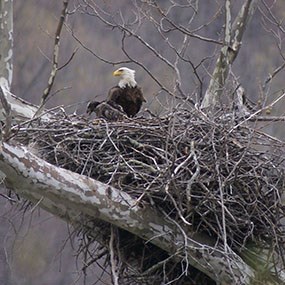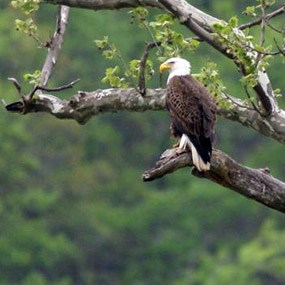
David Hypes In the past, seeing a bald eagle in New River Gorge was a rare sight. Throughout the United States their numbers were severely reduced to the point that the bald eagle was listed as a threatened and endangered species. This was primarily due to the use of pesticides like DDT. After the banning of DDT, populations returned to the point where the bald eagle was removed from the list in 2007. In recent years, the thrilling experience of seeing a bald eagle soaring over the New River has become a much more common occurrence. But for how long will this last? Today, a major threat to the health of our eagle populations in West Virginia, and throughout the country, is lead poisoning. Lead, often originating from lead bullets and sinkers, has been a cause of major health issues for birds such as eagles and vultures, who often scavenge carcasses of deer and other wildlife that may harbor lead fragments. 
David Hypes The Brooks Island EaglesThe first confirmed breeding pair of eagles in the park established a nest in the winter of 2009 to 2010. The nest was sighted in a large American sycamore tree on the downstream end of Brooks Island, in the southern part of New River Gorge National Park and Preserve. This pair of eagles laid two eggs in February 2010. Two eaglets hatched in March and were seen first taking flight in early June. 
David Hypes Bald Eagle Life HistoryBoth birds of a breeding pair share the responsibilities of building the nests, incubating the eggs and feeding the young eaglets. Nests are reused and expanded over the years sometimes growing to 5 feet in diameter, 3 feet in depth, and weighing several hundred to over one thousand pounds.
Brooks Island Eagles Photo Galleryphotos by David Hypes |
Last updated: January 22, 2024
